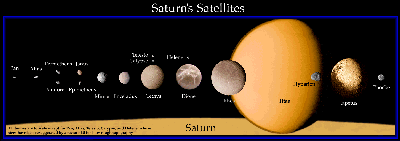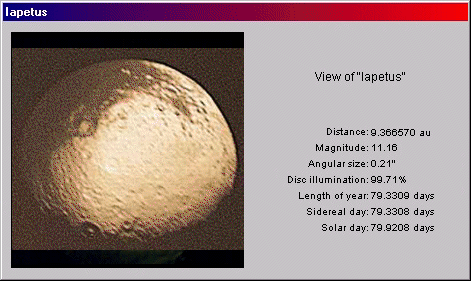

| Satellite or Moon | Distance From Satern (km) |
Radius (km) |
Discovery Date |
|---|---|---|---|
| Pan | 134 | 10 | 1990 |
| Atlas | 138 | 14 | 1980 |
| Prometheus | 139 | 46 | 1980 |
| Pandora | 142 | 46 | 1980 |
| Epimetheus | 151 | 57 | 1980 |
| Janus | 151 | 89 | 1966 |
| Mimas | 186 | 196 | 1789 |
| Enceladus | 238 | 260 | 1789 |
| Tethys | 295 | 530 | 1684 |
| Telesto | 295 | 15 | 1980 |
| Calypso | 295 | 13 | 1980 |
| Dione | 377 | 560 | 1684 |
| Helene | 377 | 16 | 1980 |
| Rhea | 527 | 765 | 1672 |
| Titan | 1222 | 2575 | 1655 |
| Hyperion | 1481 | 143 | 1848 |
| Iapetus | 3561 | 730 | 1671 |
| Phoebe | 12952 | 110 | 1898 |

Click above image for a "BIG" enlargement.

Iapetus is the subject of this color composite, prepared from images taken Aug. 22 when Voyager 2 was 1.1 million kilometers (680,000 miles) from this satellite of Saturn. The northern hemisphere is in view, including the north polar region on the right and a band of dark terrain near the equator on the left. Craters may be seen in both the dark and bright regions. Some craters in the bright region have dark floors and appear to be flooded with material that may have erupted from the interior ofthe satellite.
Voyager 2 obtained this closeup view of Saturn's satellite Hyperion on Aug. 24 from a distance of about 500,000 kilometers (300,000 miles). This photograph was compiled from three separate images taken through violet, clear and green filters. It shows Hyperion to be an irregular, disc-shaped body. Its longest dimension is 360 km. (225 mi.), but in this view, it presents a face measuring 325 km. by 250 km. (200 mi. by 150 mi.). The irregular shape is probably a result of repeated impacts that have taken off large pieces of the satellite. The large indentation at the bottom limb is one such crater; it is about 100 km. (60 mi.) across. The numerous small pits are impact craters, the smallest measuring about 10-20 km. (6-12 mi.) across.
This Voyager 2 photograph of Tethys shows objects about 5 kilometers (3 miles) in size and is one of the best images of the Saturnian satellite returned by the spacecraft or its predecessor, Voyager 1. Voyager 2 obtained this picture Aug. 26 from a range of 282,000 kilometers (175,000 miles). It has been specially processed by computer to bring out fine detail on the surface. A boundary between heavily cratered regions (top right) and more lightly cratered areas (bottom right) is very similar to boundaries on the moons Dione and Rhea, indicating a period of internal activity early in Tethys' history that partially resurfaced the older terrain. The large crater in the upper right lies almost on the huge trench system that girdles nearly three-fourths of the circumference of the satellite. The trench itself is seen in this image as a linear set of markings to the lower left of the crater. The trench, several kilometers deep, is indicative of a cold, stiff ice crust at the time of its formation. Formation of this trench system could have resulted from the expansion of Tethys as its warm interior froze.
This high-resolution image of Enceladus was made from several images obtained Aug. 25, l981, by Voyager 2 from a range of ll9,000 kilometers (74,000 miles). It shows further surface detail on this Saturnian moon. Enceladus is seen to resemble Jupiter's moon Ganymede, which is, however, about l0 times larger. Faintly visible here in light reflected from Saturn is the hemisphere turned away from the sun.
Explanation: Mimas is one of the smaller moons of Saturn but shows one of the largest impact craters! In fact, if the impact had been much greater, it would have disrupted the entire satellite. The large crater has been named Herschel after the 1789 discoverer of Mimas, Sir William Herschel. Mimas' low mass produces a surface gravity just strong enough to create a spherical body but weak enough to allow such relatively large surface features. Mimas is made of mostly water ice with a smattering of rock - so it is accurately described as a big dirty snowball.
Explanation: The largest moon of Saturn is a rare wonder. Titan is the only one of Saturn's moons with an atmosphere, and one of only two moons in the Solar System with this distinction (Neptune's Triton is the other). Titan's thick cloudy atmosphere is mostly nitrogen, like Earth's, but contains much higher percentages of "smog-like" chemicals such as methane and ethane. The smog may be so thick that it actually rains "gasoline-like" liquids. The organic nature of some of the chemicals found in Titan's atmosphere cause some to speculate that Titan may harbor life! Because of its thick cloud cover, however, Titan's actual surface properties remain mysterious.
Explanation: Rhea is the second largest moon of Saturn, behind Titan, and the largest without an atmosphere. It is composed mostly of water ice, but has a small rocky core. Rhea's rotation and orbit are locked together (just like Earth's Moon) so that one side always faces Saturn. A consequence of this is that one side always leads the other. Rhea's leading surface is much more heavily cratered than its trailing surface. The above photograph was taken with the Voyager 1 spacecraft in 1980.
Explanation: Dione, one of Saturn's larger moons, is remarkable for its bright surface streaks. These streaks run across some of Dione's many craters, which indicate that the process which created the streaks occurred later than the process which created the craters. Dione is made of mostly water ice but its relatively high density indicates that it contains much rock inside. Dione was discovered by Giovanni Cassini in 1684. NASA's Cassini mission to Saturn is currently scheduled for launch in October 1997. Dione's orbit is remarkable it that it also houses the much smaller moon Helene. This moon, once designated "Dione B", precedes Dione by about 1/6th of an orbit.
Explanation: Saturn's moon Helene is very unusual in that it circles Saturn near the orbit of a bigger moon: Dione. Helene is situated in what is called a "Lagrange point" of Dione - a place of stability created by Dione's gravity. Were Helene to stray slightly from its orbit 1/6 ahead of Dione, the larger moon's gravity would cause Helene to move back toward the Lagrange point. Many massive orbital bodies have stable Lagrange points, including the Earth and Moon. Helene was discovered from the ground by P. Laques & J. Lecacheux in 1980. The photograph above was taken by Voyager 2 as it passed Saturn in 1981.
Back To Main Menu
Use the "BACK" button on your Browser to return to the previous page.